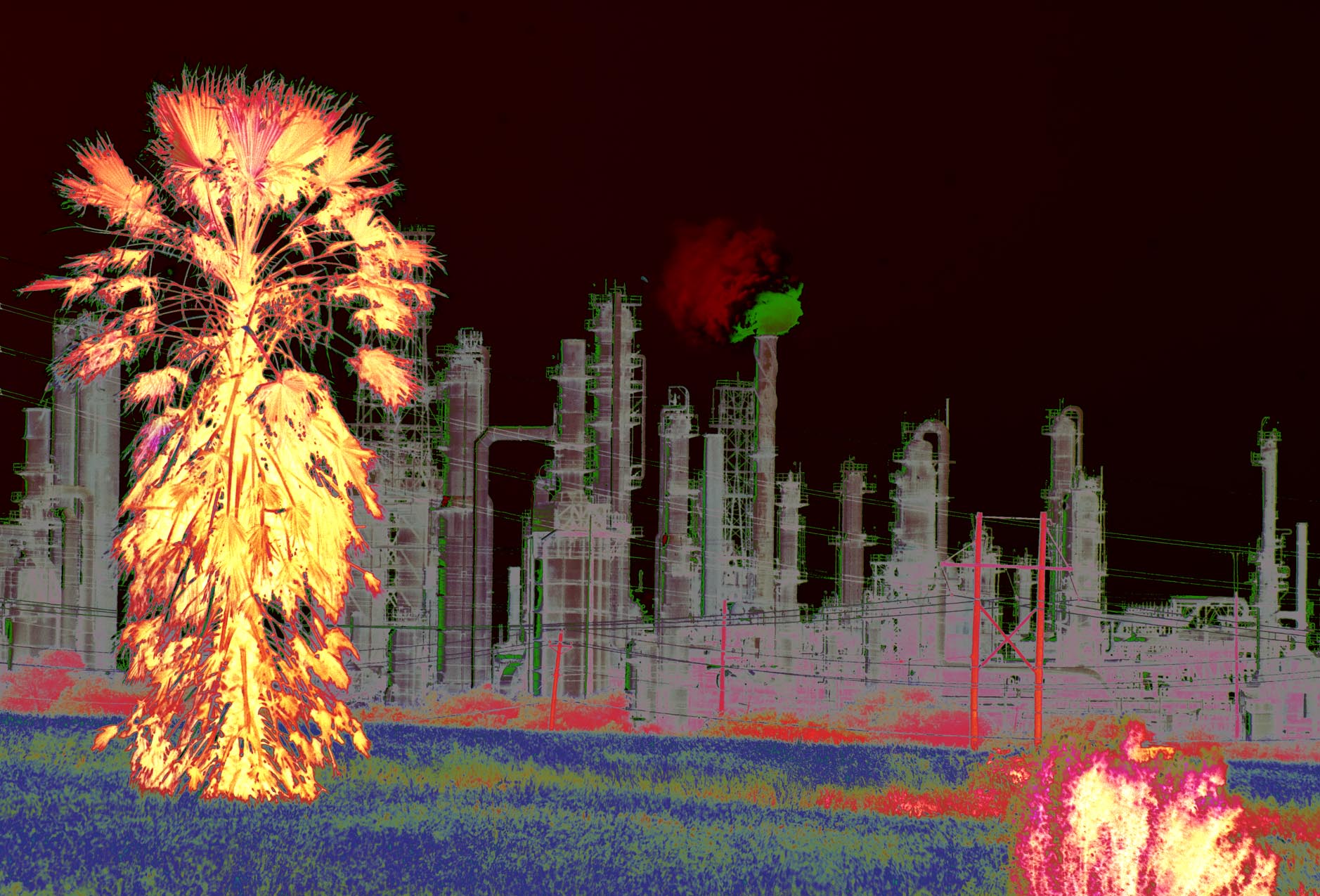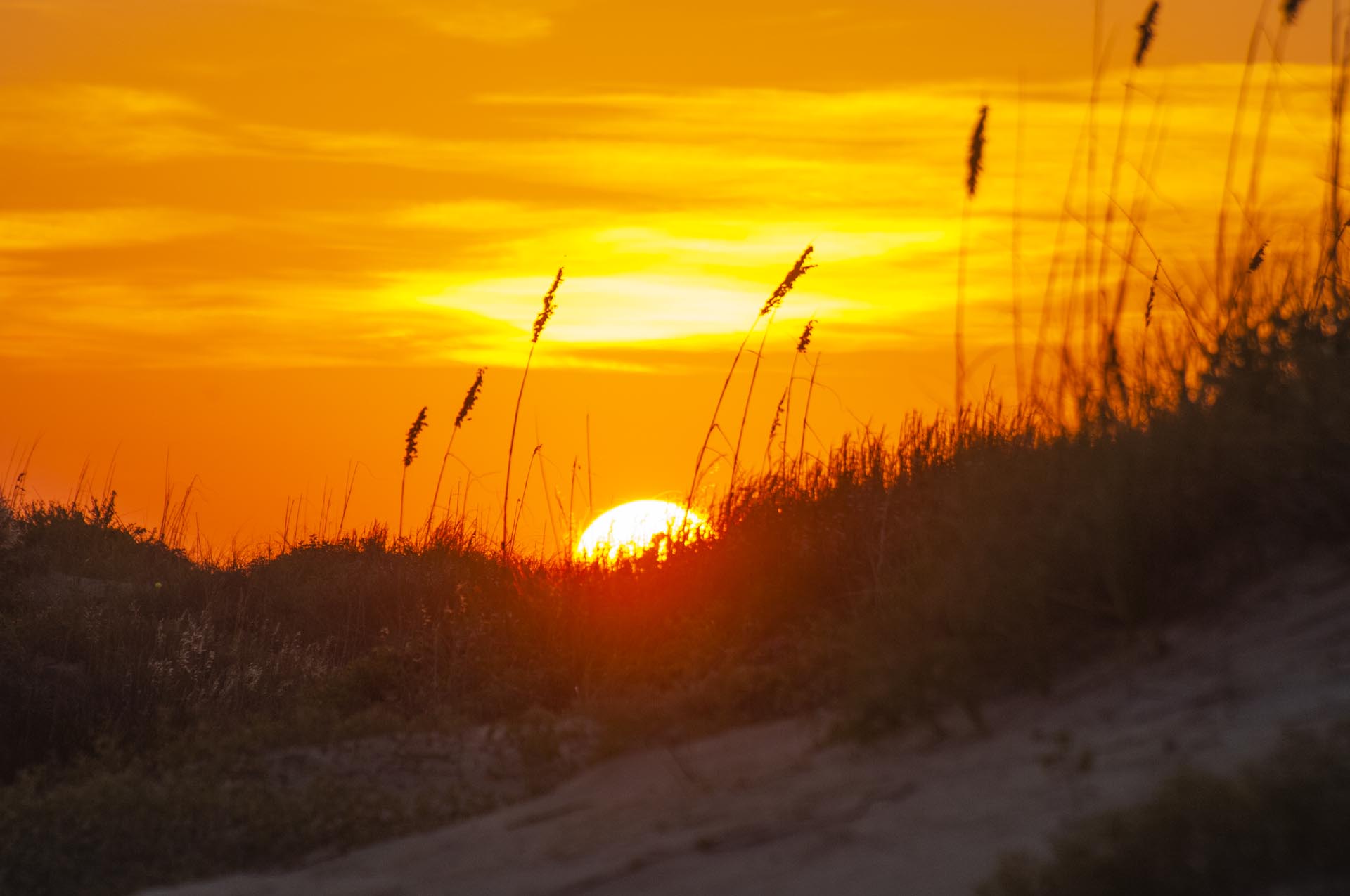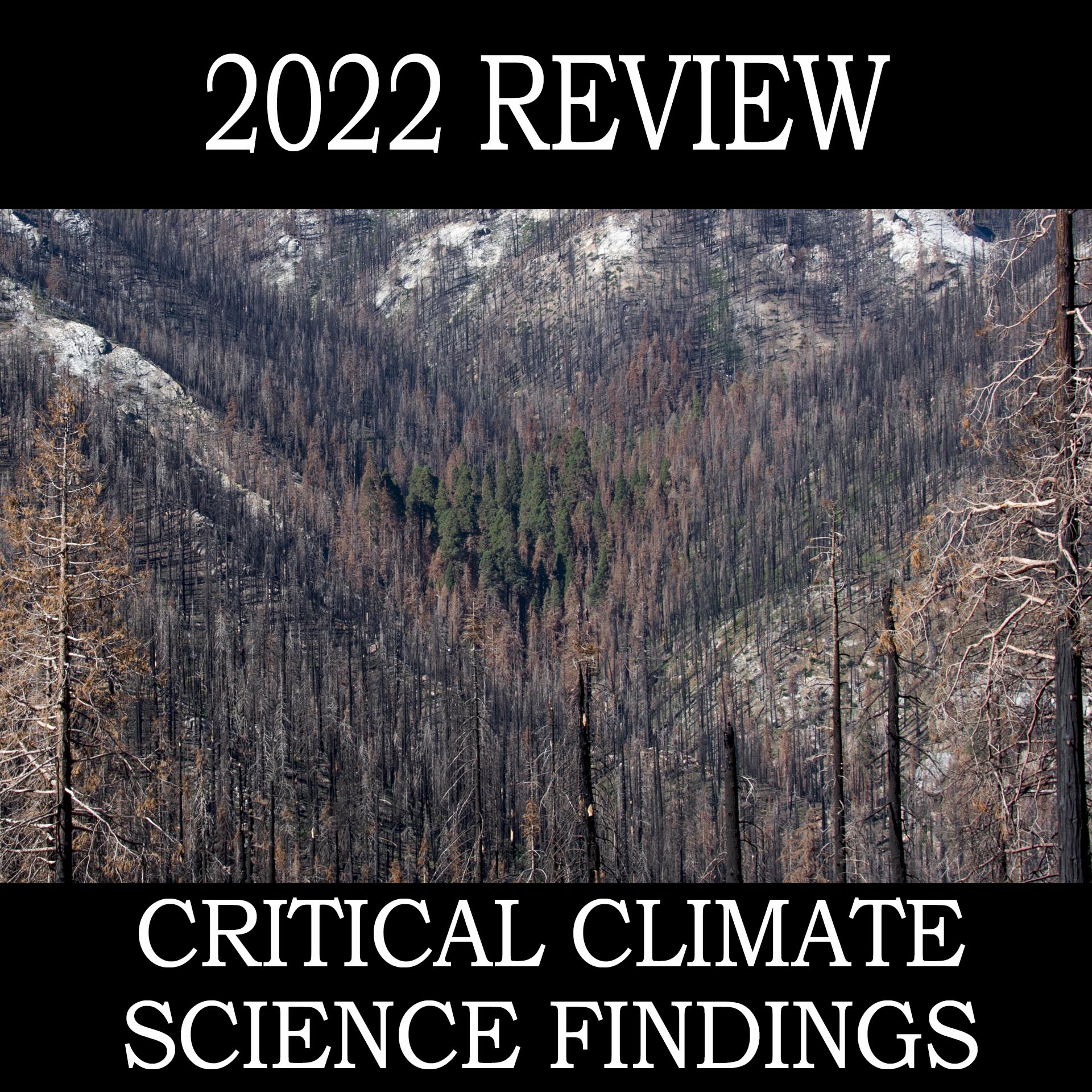 A few sequoias saved from the KNP fire.
A few sequoias saved from the KNP fire.
2022 Review – Critical Climate Science Findings
Below are some of the scientific findings that made our archives in 2022. These are just a fraction of what made it into the archives, but they represent the most important aspects of climate change impacts happening far ahead of projections and other issues that are critical to the climate emergency. What is important about these selections, and about the mission of the Climate Change Now Initiative, is how these impacts and issues relate to advancing policy into the realm of climate restoration, so as to stabilize Earth systems tipping collapses that are now active generations ahead of projections, instead of allowing further warming to 1.5 C that ensures tipping will become irreversible with existential outcomes.
Latest from James Hansen on multiple critical developments with our rapidly changing climate and the most recent science … Hansen was the 32 year director (retired) of the NASA Goddard Institute for Space Studies, the de facto US climate modeling agency, and the developer of the 350 ppm CO2 warming target to restore our climate to within the boundaries of Earth’s systems and prevent untenable collapse.
- Climate sensitivity is greater than previously thought with CO2 at 560 ppm by mid-century (normal is 280, 420 now) average warming is 2.3 C (4 F), or 8 F over land.
- The rate of global warming has recently doubled.
- We are increasing climate forcing twenty times faster than the Paleocene-Eocene Thermal Maximum (PETM)an abrupt warming of 6 C ( 11 F) 55 million years ago from massive volcanism creating the largest ocean extinction event in 93 million years.
- Solar Radiation Management (SRM) – This is critical for someone like Hansen to say things like this, “it may be necessary to temporarily affect Earth’s energy imbalance via solar radiation management (SRM).”
Hansen Newsletter Summary:
https://mailchi.mp/caa/global-warming-in-the-pipeline?e=a29768a646
Full paper PDF:
https://arxiv.org/pdf/2212.04474.pdf
Clubhouse podcast interview with Leon Simons, a co-author, 2.5 hours.
https://www.clubhouse.com/room/MKVLW5Wx?utm_medium=ch_room_xerc&utm_campaign=JXq0RHi9uzX4m75doji2uw-507541
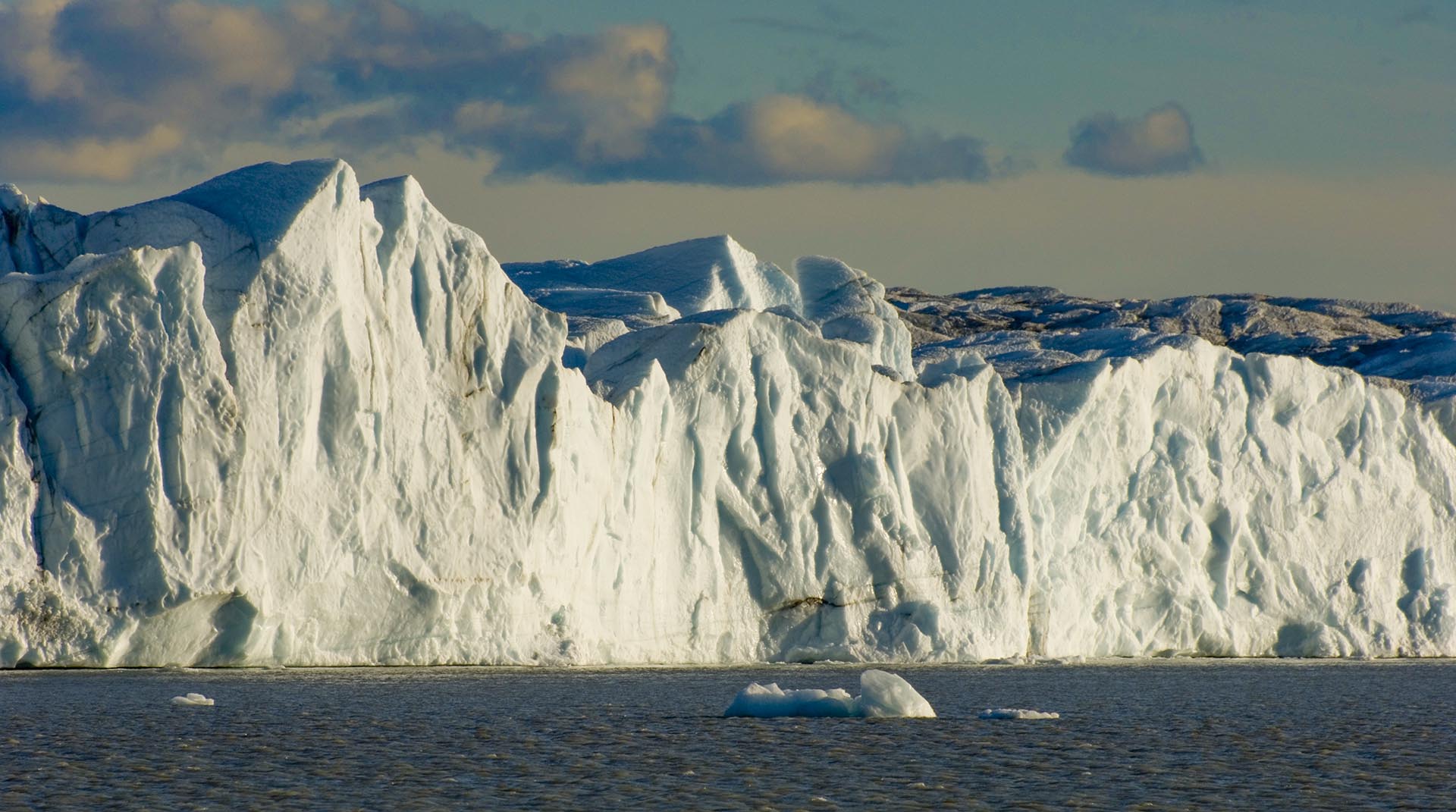 Russell Glacier, Kangerlussuaq, Greenland
Russell Glacier, Kangerlussuaq, Greenland
Greenland ice stream frontal melt may 100 times greater than thought… Though most of Greenland’s contribution to sea level rise comes from ice discharge and surface melt, this new work is pivotal in ice stream flow dynamics where greater frontal melt of ice streams means greater stress on the ice stream allowing higher ice discharge rates.
Schulz et al, An Improved and Observationally-Constrained Melt Rate Parameterization for Vertical Ice Fronts of Marine Terminating Glaciers, Geophysical Research Letters, September 19, 2022.
https://agupubs.onlinelibrary.wiley.com/doi/10.1029/2022GL100654
The Arctic is warming four times faster than the rest of the world… Continued warming means that the Arctic is not warming twice as much as the global average any longer, but four times as much.
Rantanen et al., The Arctic has warmed nearly four times faster than the globe since 1979, Nature Communications, August 11, 2022.
https://www.nature.com/articles/s43247-022-00498-3
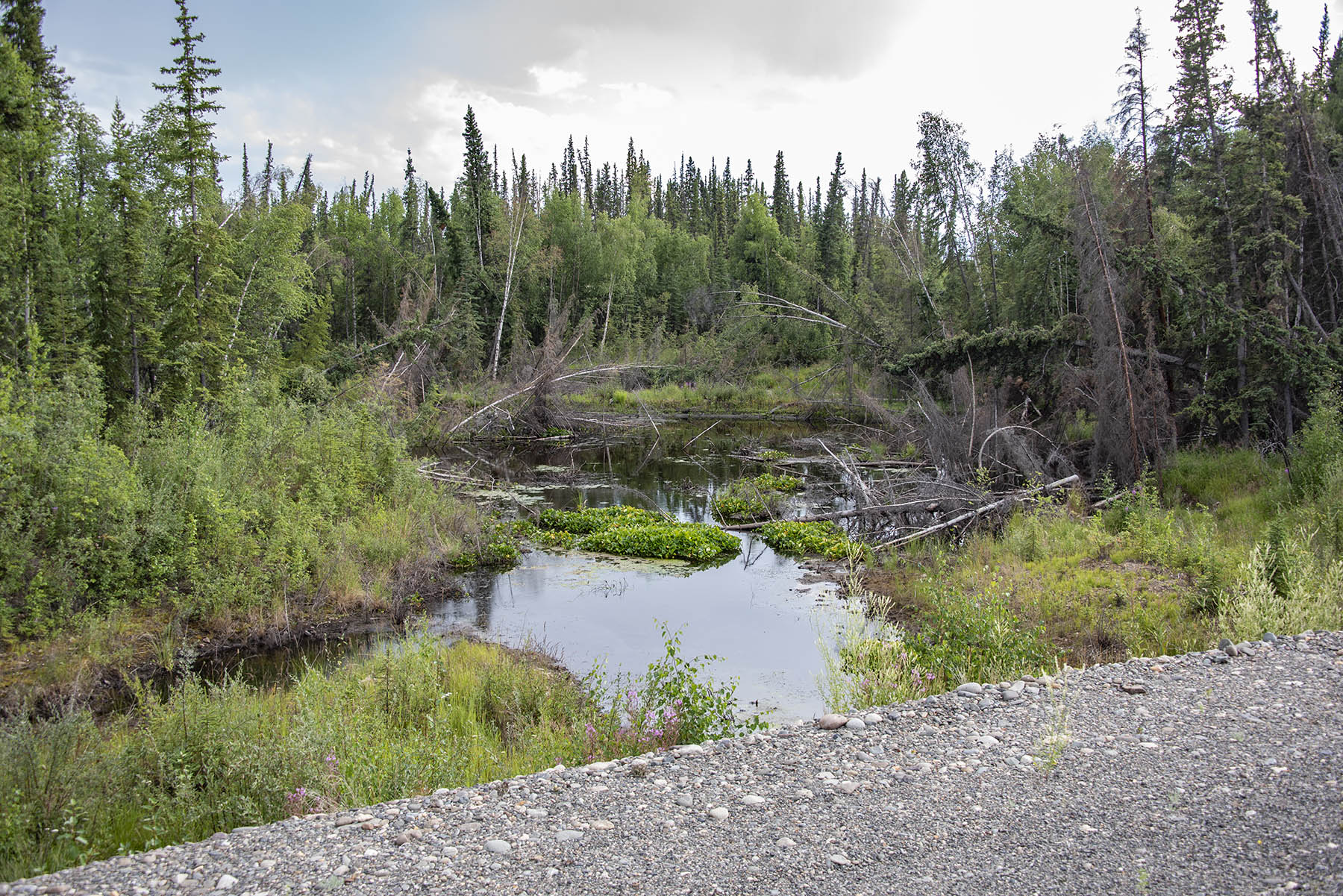 Permafrost melt, Alaska Highway, Yukon Territory
Permafrost melt, Alaska Highway, Yukon Territory
Massive floods caused the closure of both Yellowstone and Death Valley National Parks… The video below has footage that didn’t make the news cycle with Yellowstone’s flood. Also note, NPS says this 7.5 to 9.5 inch event was a 500-year storm. I am a hydrologist and checked their work which was not displayed. The 100-year storm in Yellowstone (in our old climate) is 3 inches, the 50-year is 2.6, the 25 is 2.2, the 10 is 1.8. Extrapolating using semi log paper as per NOAA guidelines, this 7.5″ to 9″ event was easily in excess of a 10,000 year event, in our old climate.
Yellowstone, June 13 2022, https://www.nps.gov/yell/planyourvisit/flood-recovery.htm
Death Valley, August 5, 2022, https://www.nps.gov/deva/learn/nature/deva-deluge-2022.htm
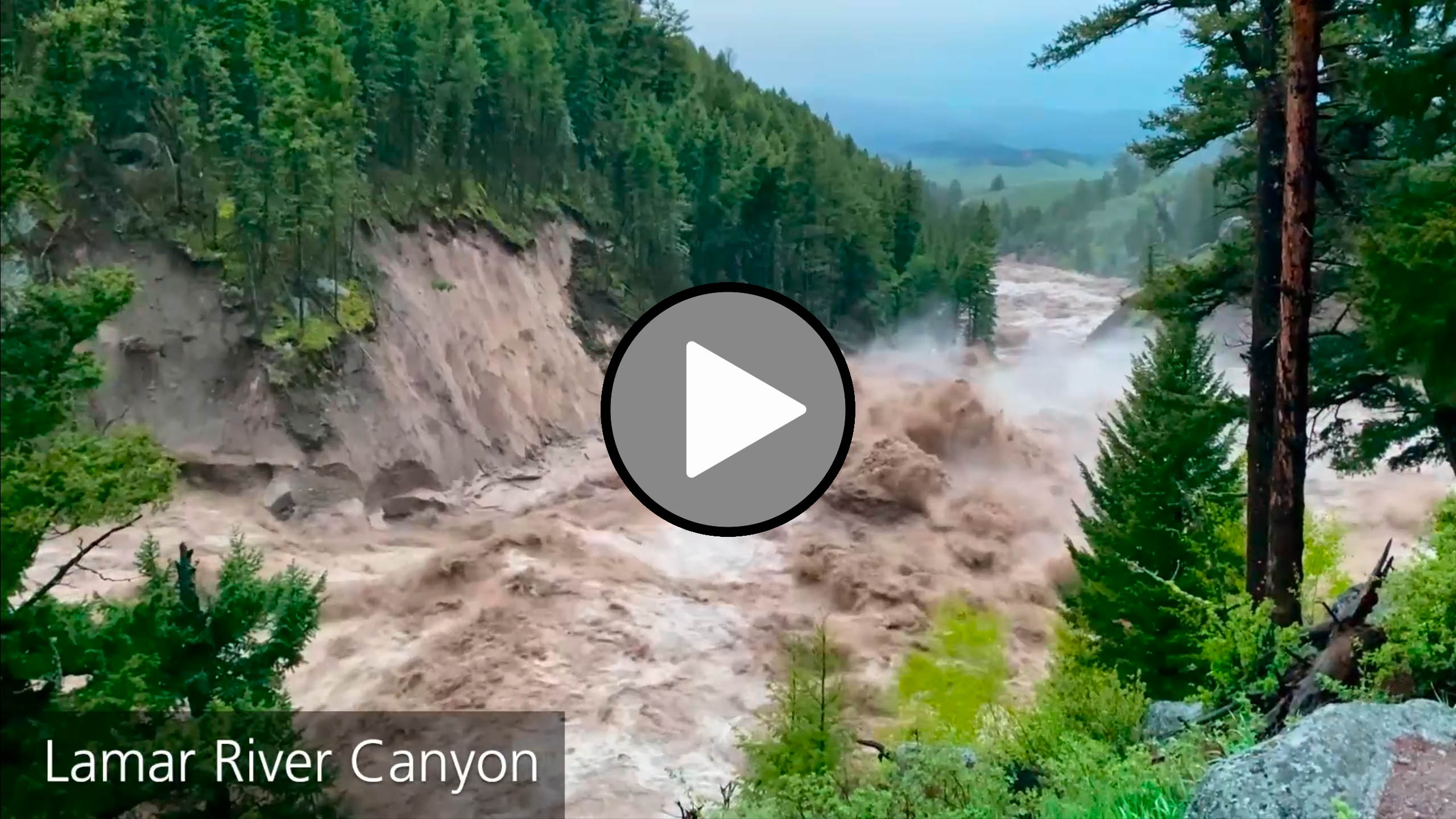 Video Link – https://www.nps.gov/media/video/view.htm?id=62FEFC5A-F12D-44BA-AC26-AE6ACDA14AA0
Video Link – https://www.nps.gov/media/video/view.htm?id=62FEFC5A-F12D-44BA-AC26-AE6ACDA14AA0
Highest methane emissions ever recorded despite decrease of human emissions during Covid attributed to less air pollution and increasing natural emissions including permafrost… Human methane emissions fell during covid, but natural emissions increased, partly because NOX emissions decreased creating fewer hydroxyl radicals that react with methane, and partly because of increasing high latitude methane emissions from permafrost thaw and resulting increased wetlands.
Peng et al., Wetland emission and atmospheric sink changes explain methane growth in 2020, Nature, December 14, 2022.
https://www.nature.com/articles/s41586-022-05447-w#:~:text=Atmospheric%20methane%20growth%20reached%20an,in%202020%20compared%20with%202019.
Globally, extremely hot days have more than doubled since 1980… Nearly 500,000 heat related deaths have been recorded. Global burned area has more than doubled since 2010 and in the US since 2000… BBC research, not peer reviewed, with support of University of Oxford, Berkeley Earth and Carbon Brief.
Dale and Stylianou, Climate change: World now sees twice as many days over 50C, BBC Data Analysis, September 13, 2021
https://www.bbc.com/news/science-environment-58494641
The amount of land pledged by nations to remove carbon from the atmosphere is 1.2 billion acres, about the same as global agriculture…
Dooley et al., The Land Gap Report, 2022.
https://www.landgap.org/storage/2022/11/Land-Gap-Report_FINAL.pdf
https://www.landgap.org/
From 2000 to 2019 the Amazon had an above ground carbon loss of 0.6 gigatons, or 2.45 Gt CO2eq, with 73 percent from forest degradation and 27 percent from deforestation… This is the second major finding that the Amazon has flipped from carbon sink to carbon source mostly because of forest mortality from water stress and not deforestation. See also Gatti 2019.
Qin et al., Carbon loss from forest degradation exceeds that from deforestation in the Brazilian Amazon, Nature Climate Change, April 29, 2021.
https://arxiv.org/ftp/arxiv/papers/2206/2206.07363.pdf
See also, 1 Gt annual greenhouse gas emissions from the Amazon…
Gatti et al., Amazonia as a carbon source linked to deforestation and climate change, Nature, July 14, 2021.
https://www.nature.com/articles/s41586-021-03629-6
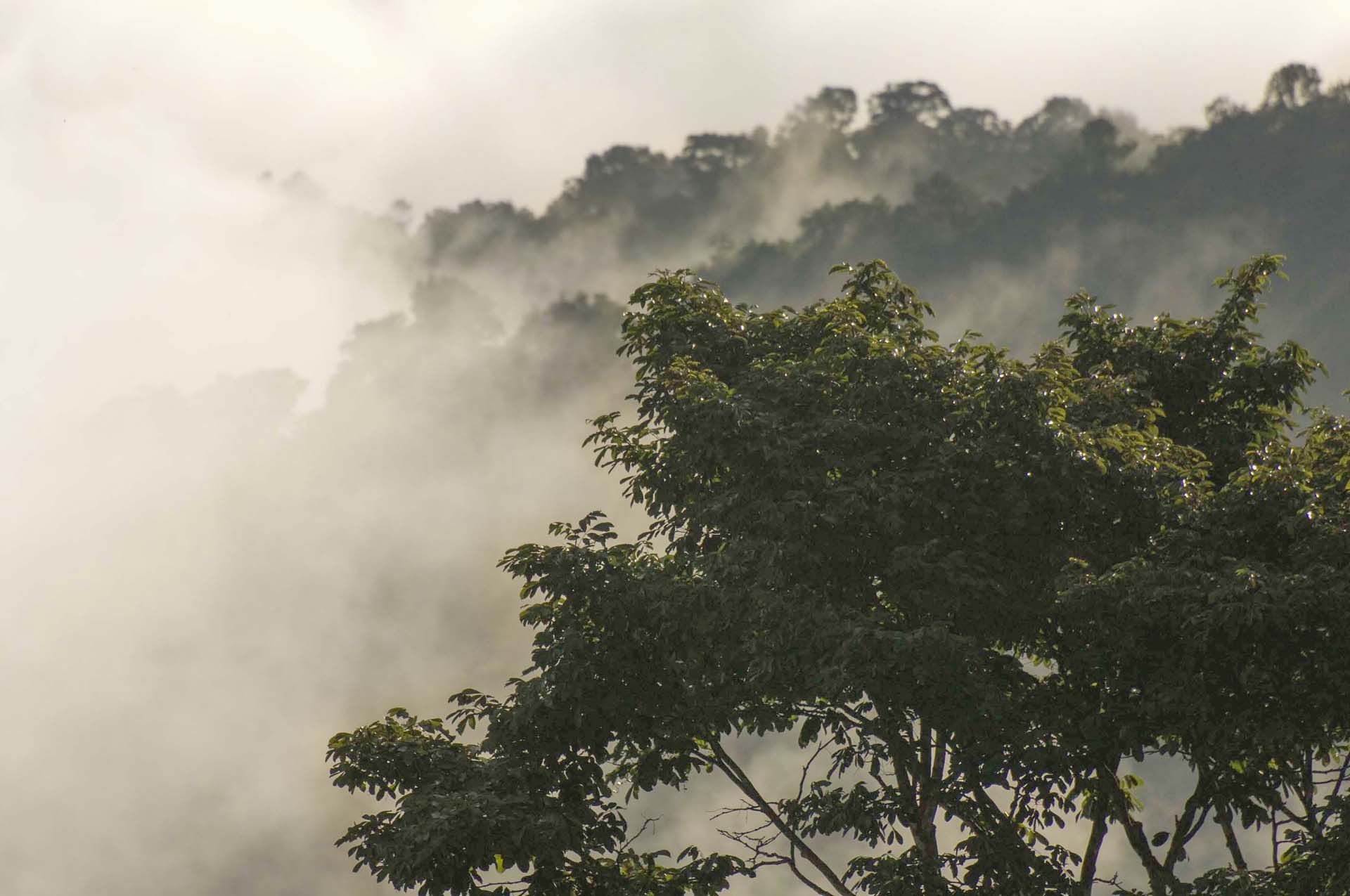 The Amazon has flipped from carbon sink to emissions because of drought,
The Amazon has flipped from carbon sink to emissions because of drought,
where deforestation is only a small contributor
The southwestern North American megadrought is now the most extreme in over 1,200 years — the greatest for which we have proxy records… This doubles the time frame from previous findings.
Williams et al., Rapid intensification of the emerging southwestern North American megadrought in 2020–202, Nature Climate Change, February 14, 2022.
https://escholarship.org/content/qt6sm1c6hf/qt6sm1c6hf_noSplash_2b3c87cbd9e5a8f9cb58a824b0050f10.pdf
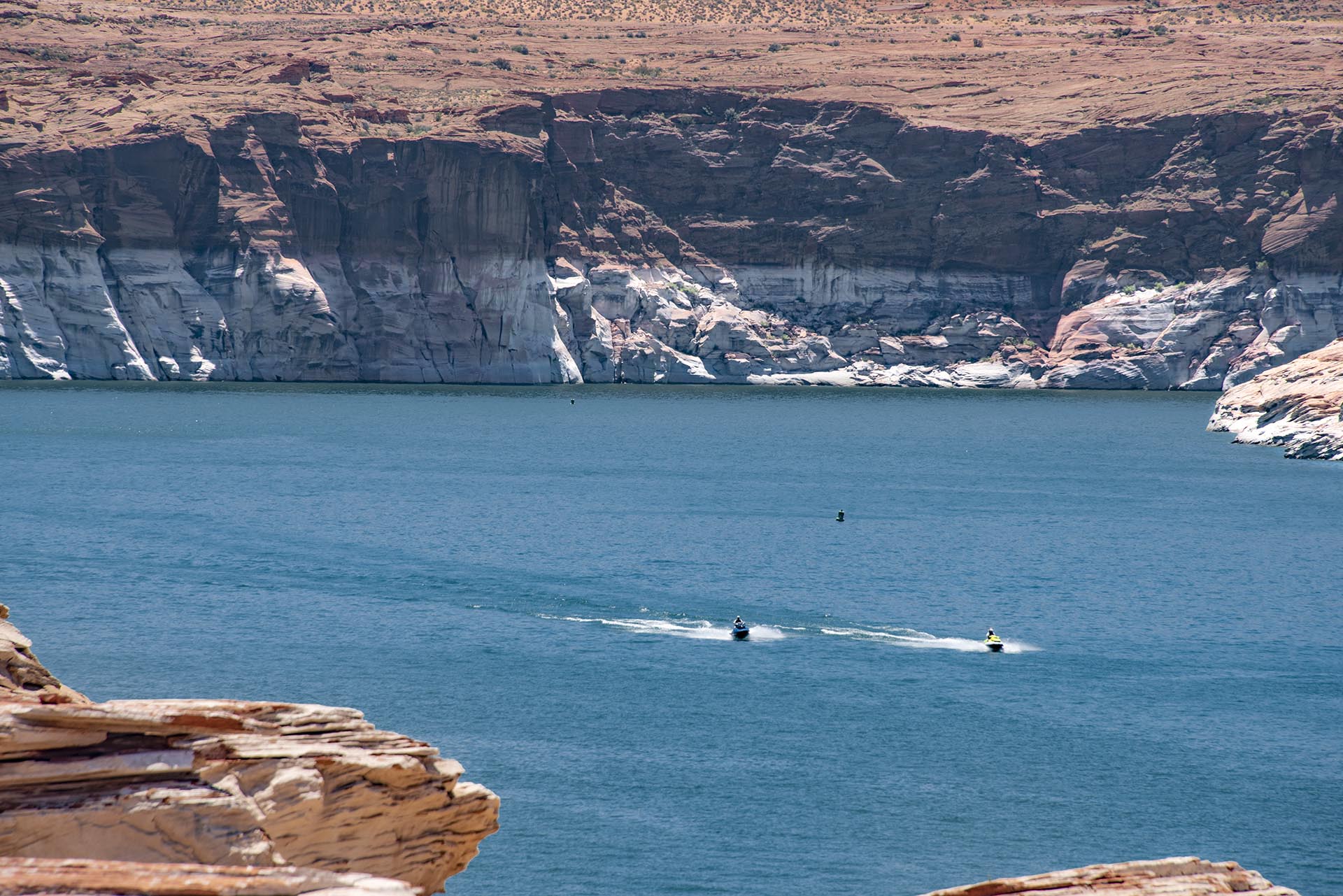 Lake Powell in 2019, elevation 3,619. Today, the water surface elevation is 3,525.
Lake Powell in 2019, elevation 3,619. Today, the water surface elevation is 3,525.
Fire
Australian 2020 fires’ unprecedented puncture of the stratosphere… The fires of 2020 created an unprecedented puncture of the stratosphere with a smoke column 50 percent higher than the tallest thunderstorm ever recorded creating a 700 mile vortex that persisted for for 13 weeks. The smoke in the stratosphere generated an average cooling effect across the globe similar to a medium size volcanic eruption.
Khaykin et al,. The 2019 to 20 Australian wildfires generated a persistent smoke-charged vortex rising up to 35 km altitude, Nature Communications Earth and Environmental, September 21, 2020.
https://www.nature.com/articles/s43247-020-00022-5.
Western wildfires increase extreme weather in the Central US… Abstract, “Western US wildfires notably increase the occurrences of heavy precipitation rates by 38% and significant severe hail (≥2 in.) by 34% in the central United States.”
Zhang et al., Notable impact of wildfires in the western United States on weather hazards in the central United States, PNAS, October 17, 2022.
https://www.pnas.org/doi/epdf/10.1073/pnas.2207329119
California’s 100-year carbon credit buffer pool has almost completely burned showing extreme lack of permanence…
Badgley et al., California’s forest carbon offsets buffer pool is severely undercapitalized, Frontiers in Forests and Global Change, August 5, 2022.
https://www.frontiersin.org/articles/10.3389/ffgc.2022.930426/full
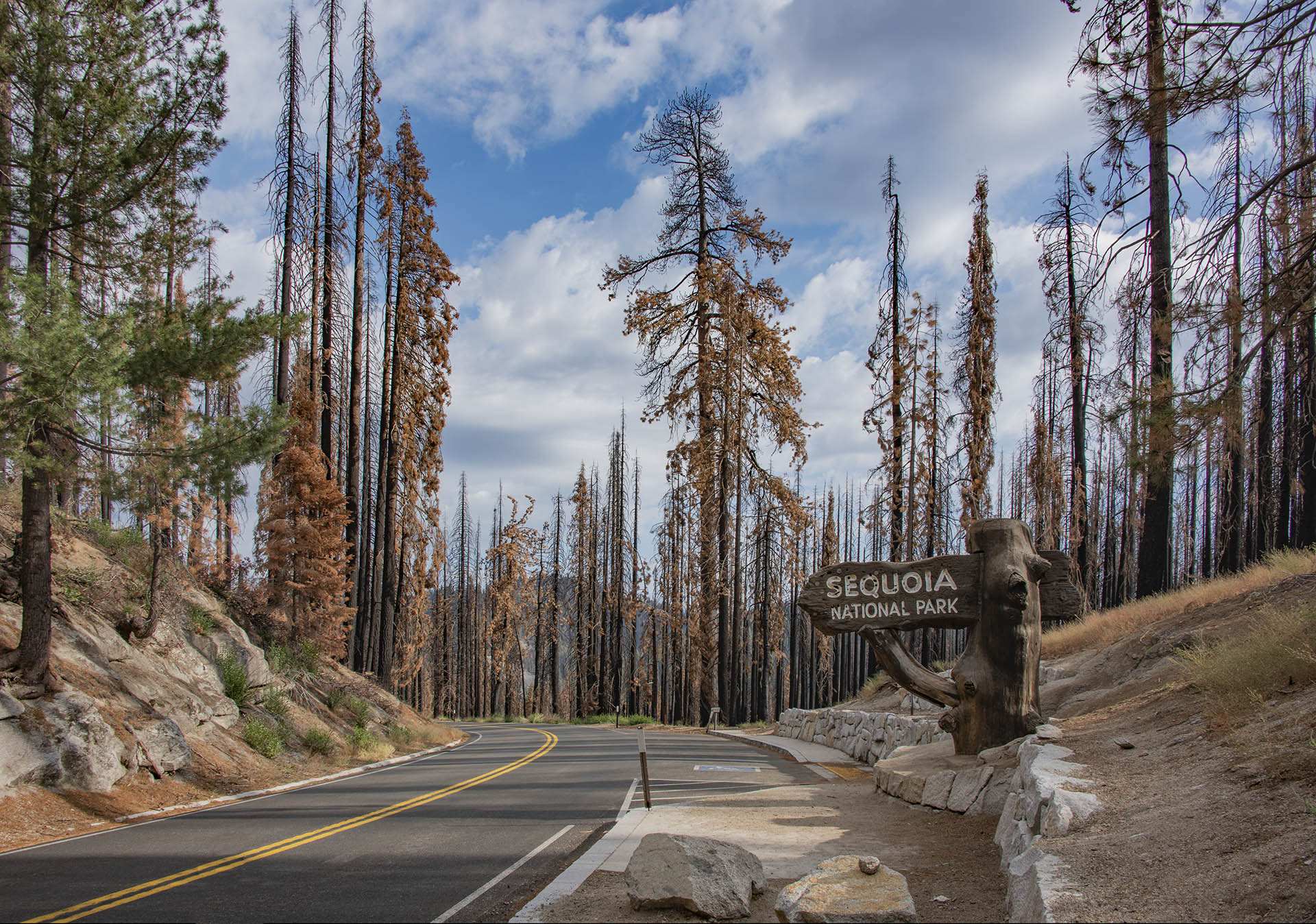 Entry Monument to Sequoia National Park after the KNP Fire in 2021
Entry Monument to Sequoia National Park after the KNP Fire in 2021
Large wildfires in California are responsible for 97 percent of the area burned in California in the last two decades… Large fires have increased significantly in the last two decades with the cause being climate warming related.
Li and Banerjee, Spatial and temporal pattern of wildfires in California from 2000 to 2019, Nature Scientific Reports, April 22, 2021.
https://www.nature.com/articles/s41598-021-88131-9
NASA Jet Propulsion Lab discussion of climate change and California’s significantly unprecedented 2020 fire season… Climate change, increased fuels from beetle kill and fire suppression, and increased urbanization were the cause that burned 17,800 structures.
Buis, The Climate Connections of a Record Fire Year in the U.S. West, NASA Jet Propulsion Lab, February 22, 2021.
https://climate.nasa.gov/ask-nasa-climate/3066/the-climate-connections-of-a-record-fire-year-in-the-us-west/
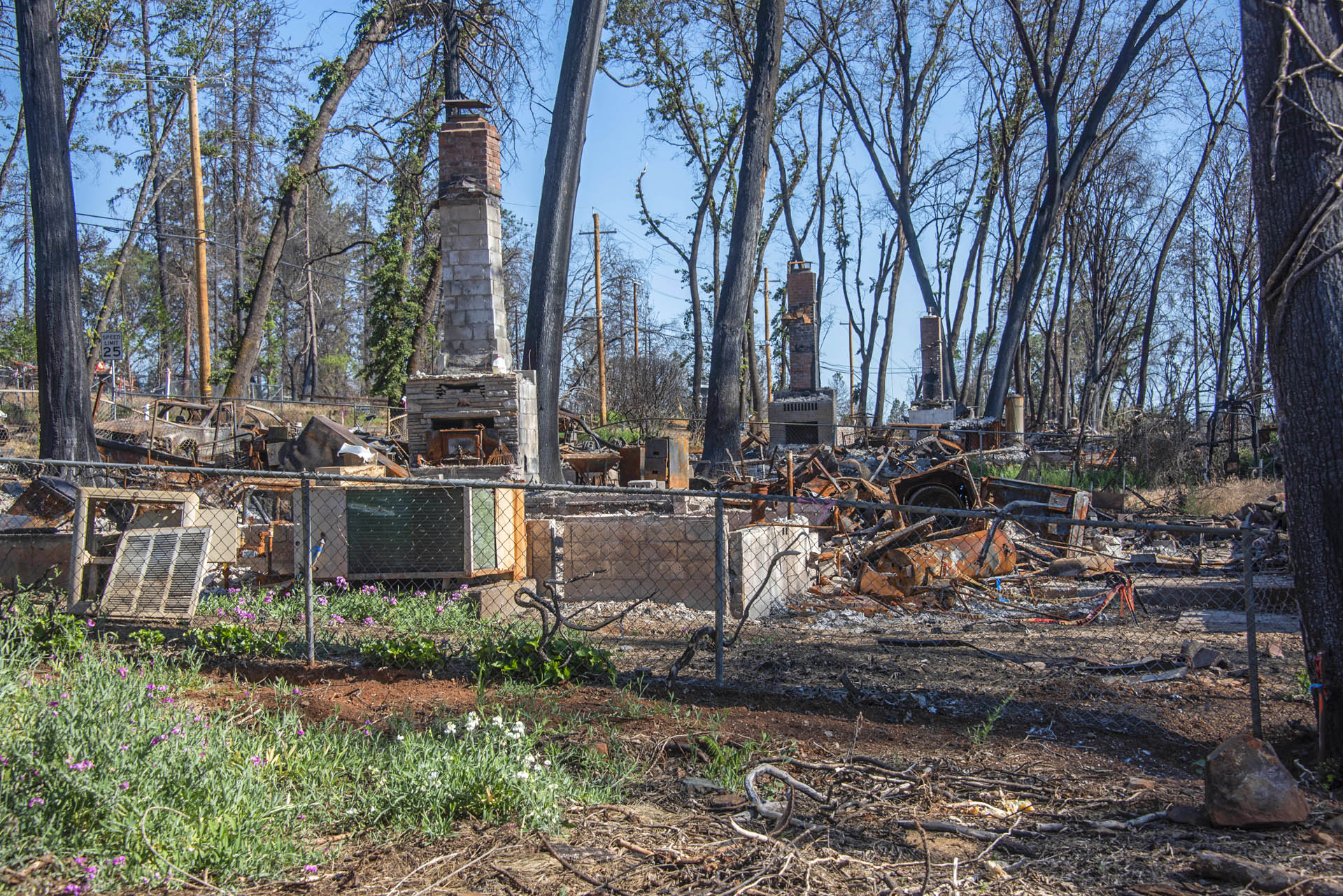 Paradise California after the Camp Fire in 2018 where 14,500 homes were burned.
Paradise California after the Camp Fire in 2018 where 14,500 homes were burned.
National Park Service says sequoias have reached a tipping point with fire… “More than 85 percent of all giant sequoia grove acreage across the Sierra Nevada has burned in wildfires between 2015 and 2021, compared to only one quarter in the preceding century.”
Wildfires Kill Unprecedented Numbers of Large Sequoia Trees, Six Fires in Six Years, Sequoia and Kings Canyon National Parks, February 25, 2022.
https://www.nps.gov/articles/000/wildfires-kill-unprecedented-numbers-of-large-sequoia-trees.htm
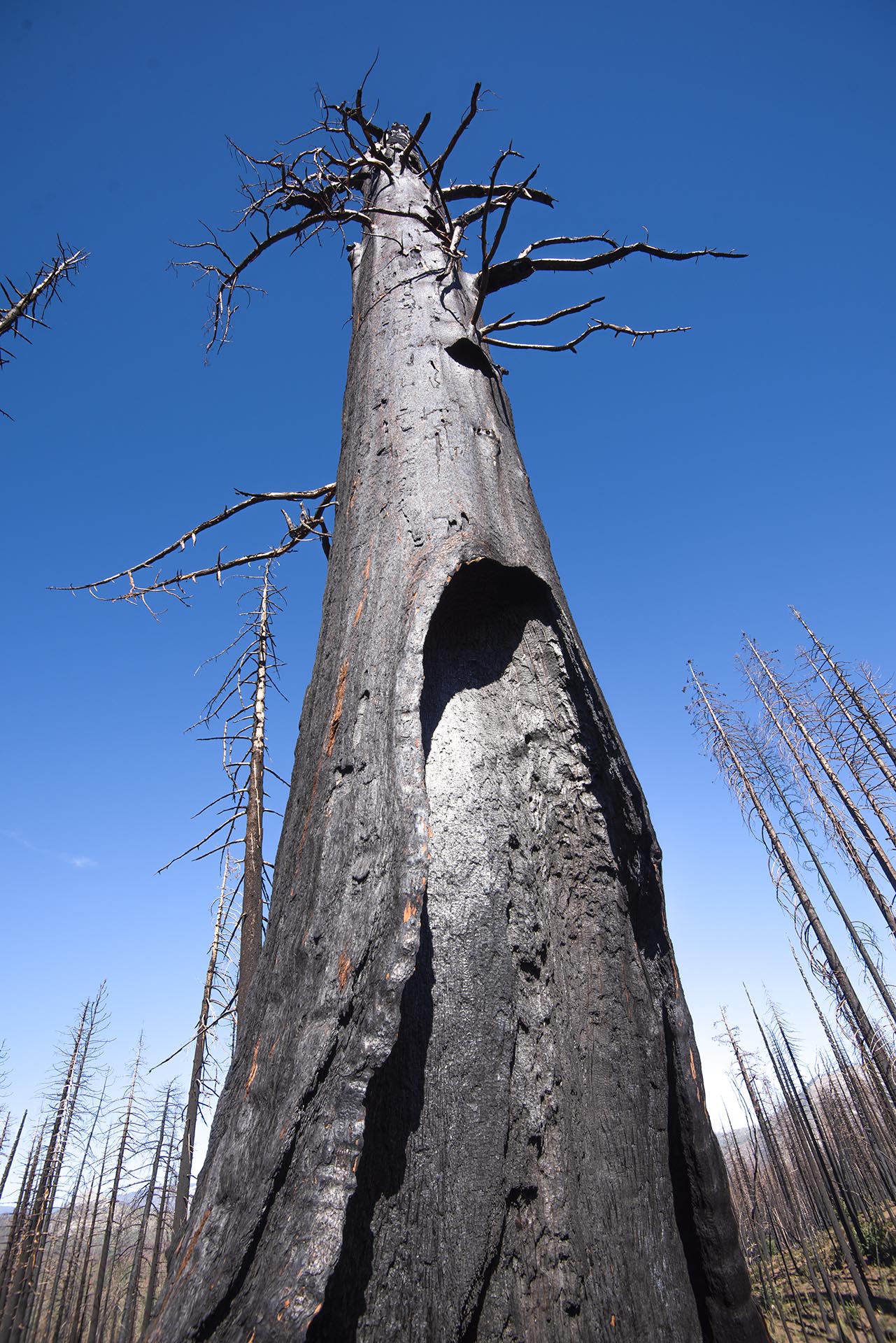 Giant sequoia burned in the Castle Fire 2020, Freeman Creek Grove, Sequoia National Forest
Giant sequoia burned in the Castle Fire 2020, Freeman Creek Grove, Sequoia National Forest
Canada’s forests have flipped from sink to emissions, mostly from beetle kill… According to the Canadian National Forest Service, Canadian forests are now emitting up to 350 Mt CO2eq per year, half of Canada’s annual human-caused emissions.
State of Canada’s Forests 2021, Natural Resources Canada.
https://www.nrcan.gc.ca/sites/nrcan/files/forest/sof2022/SoF_Annual2022_EN_access.pdf
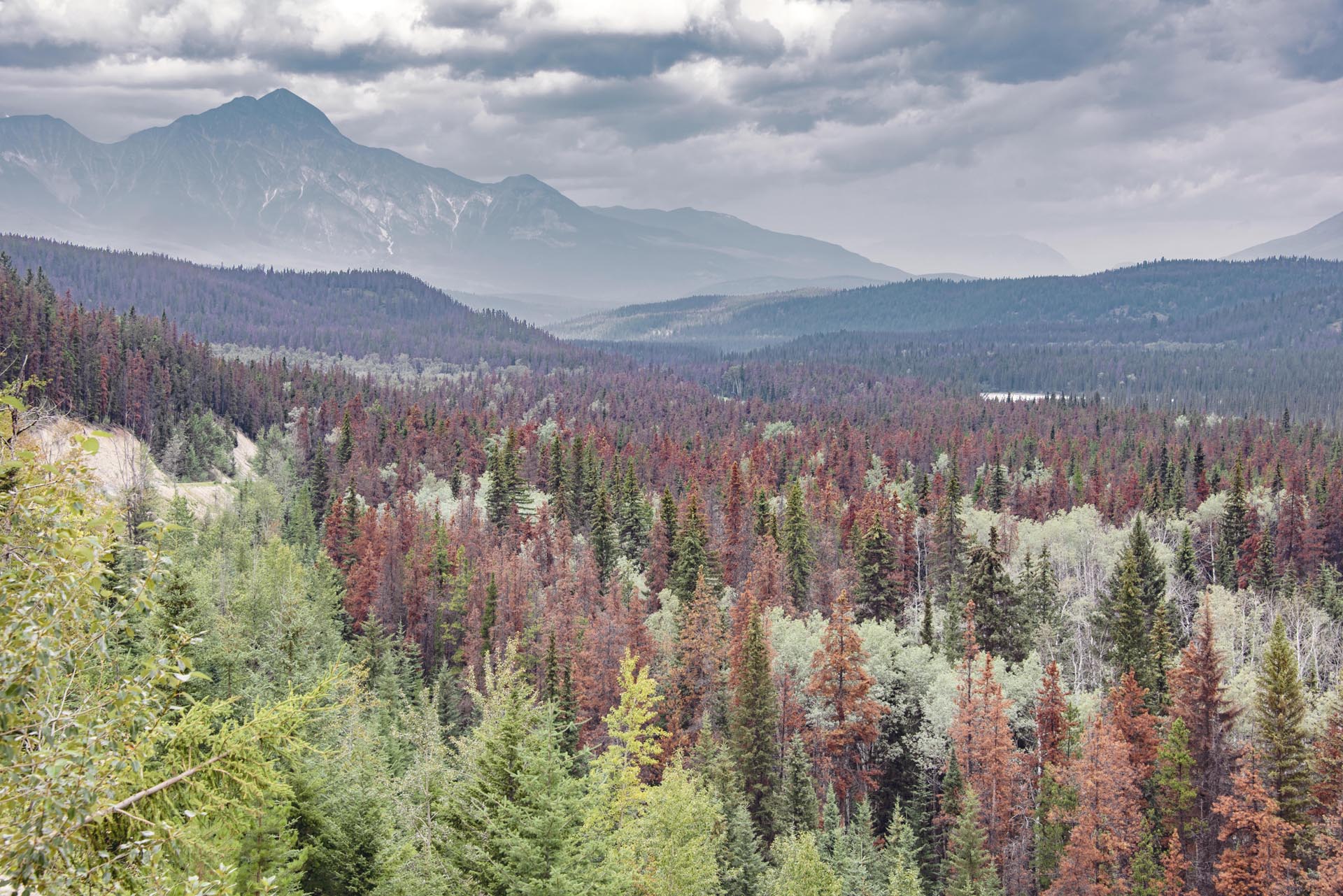 Jasper National Park, British Columbia, Canada.
Jasper National Park, British Columbia, Canada.
Red is bark beetle kill in conifers, light gray-green is leaf miner in aspen
Global vegetation resilience rates from climate change are generally decreasing, especially in the short term. The cause is warming and water stress from climate change.
Smith et al., Empirical evidence for recent global shifts in vegetation resilience, Nature Climate Change, April 28, 2022.
https://www.nature.com/articles/s41558-022-01352-2
Forest regeneration after wildfire in the West, an era where forests may not return… The increasing extremeness of fires, plus climate warming, plus local effects of extreme fire that increase local aridity, have all resulted in forests not regenerating after fire.
Coop et al., Wildfire Driven Forest Conversion in Western North American Landscapes, BioScience, July 1, 2020.
https://doi.org/10.1093/biosci/biaa061
 Mesa Verde National Park pinyon-juniper forest regeneration failure after turn of the century wildfires
Mesa Verde National Park pinyon-juniper forest regeneration failure after turn of the century wildfires
Poor ponderosa pine regeneration because of climate warming and moisture limitation…
Singleton, Moisture and vegetation cover limit ponderosa pine regeneration in high-severity burn patches in the southwestern US, Fire Ecology, May 7, 2021.
https://fireecology.springeropen.com/articles/10.1186/s42408-021-00095-3
Pinyon juniper woodlands in Mesa Verde are not regenerating after turn of the century fire… Research was from the Natural History Institute and Colorado State University. Also see our Fall 2021 Trip Report with more images of the mesa tops that burned around the turn of the century, that are coming back as grasslands.
Floyd et al., Effects of Recent Wildfires in Pinon-Juniper Woodlands of Mesa Verde, Bio One, February 2021.
(Researchgate – Free subscription required) https://www.researchgate.net/publication/349013945_Effects_of_Recent_Wildfires_in_Pinon-Juniper_Woodlands_of_Mesa_Verde_National_Park_Colorado_USA
Fall Filming Report 2021
https://climatediscovery.org/11093/
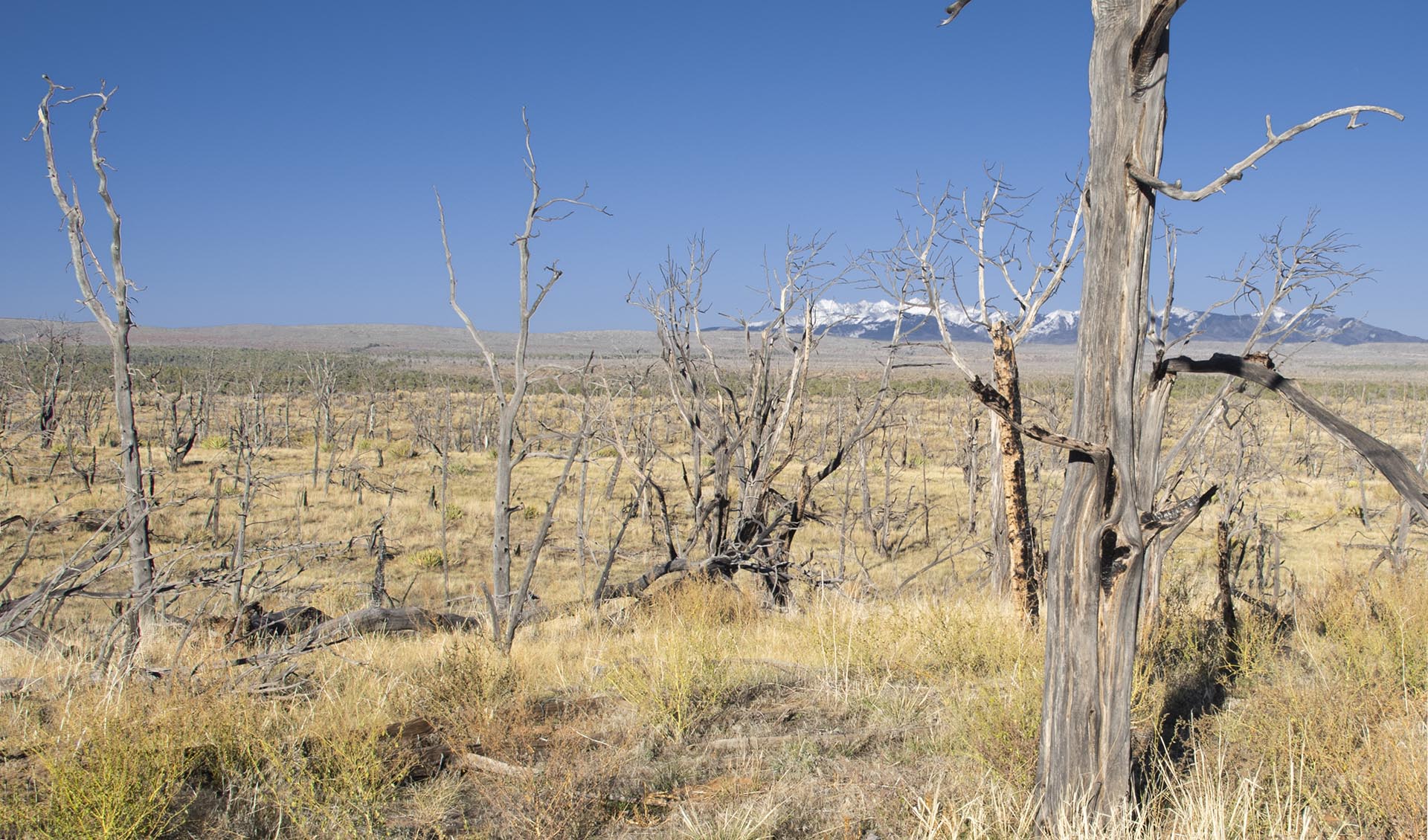 Mesa Verde National Park pinyon-juniper forest regeneration failure
Mesa Verde National Park pinyon-juniper forest regeneration failure
after turn of the century wildfires
La Plata Mountains in Colorado in the background
Siberia forest fire threshold crossed… “Satellite observations reveal that fires burned about 11.6 million acres in 2019 and 2020, accounting for 44% of the total burned area in the Siberian Arctic for the entire 1982–2020 period.”
Descals, Unprecedented fire activity above the Arctic Circle linked to rising temperatures, Science, November 3, 2022.
https://www.science.org/doi/10.1126/science.abn9768
Forest fuels reductions strategies in California, in combination with climate warming, reduce California’s above ground carbon stocks 75 percent by 2040 to 2069… Climate conditions modeled in 2040 to 2069 are similar to turn of the century California forest in low density of biomass, which is the main goal of forest fuels reduction strategies of prescribed burning that increases resilience to fire. This resilience comes at a price though, of a forest with 75 percent less carbon storage and that by mid-century, California’s forests will have emitted a gigatons of carbon or 3.7 gigatons of CO2 equivalents.
Bernal et al., Biomass stocks in California’s fire-prone forests, mismatch in ecology and policy, Environmental Research Letters, March 25, 2022.
https://iopscience.iop.org/article/10.1088/1748-9326/ac576a/pdf
Post-fire regeneration, regrowth, forest recovery… One third of burned forests in the US West since 2000 are not regenerating at all and half of the rest are regenerating at only half of the 20th century rate.
Stevens-Rumann et al., Evidence for declining forest resilience to wildfires under climate change, Ecology Letters, December 12, 2018.
https://www.firescience.gov/projects/16-1-01-15/project/16-1-01-15_Stevens-Rumann_et_al_2018_Ecology_Letters.pdf
Area burned globally doubled 2001 to 2018, 10 times more in tropical forests…
MacCarthy et al., New Data Confirms: Forest Fires Are Getting Worse, World Resources Institute, August 17, 2022.
https://www.wri.org/insights/global-trends-forest-fires
Full paper – Tyukavina et al., Global Trends of Forest Loss Due to Fire From 2001 to 2019, Frontiers in Remote Sensing, March 15, 2022.
https://www.frontiersin.org/articles/10.3389/frsen.2022.825190/full
Eightfold increase in high severity fire between 1985 and 2017…
US Forest Service summary article – Area burned at high severity is increasing in western U.S. forests, USFS, January 19, 2021.
https://www.fs.usda.gov/rmrs/science-spotlights/area-burned-high-severity-increasing-western-us-forests
Full paper – Parks and Abatzoglou, Warmer and drier fire seasons contribute to increases in area burned at high severity in western US forests from 1985 to 2017, Rocky Mountain Research Station, November 18, 2020.
https://www.fs.usda.gov/rmrs/publications/warmer-and-drier-fire-seasons-contribute-increases-area-burned-high-severity-western-us
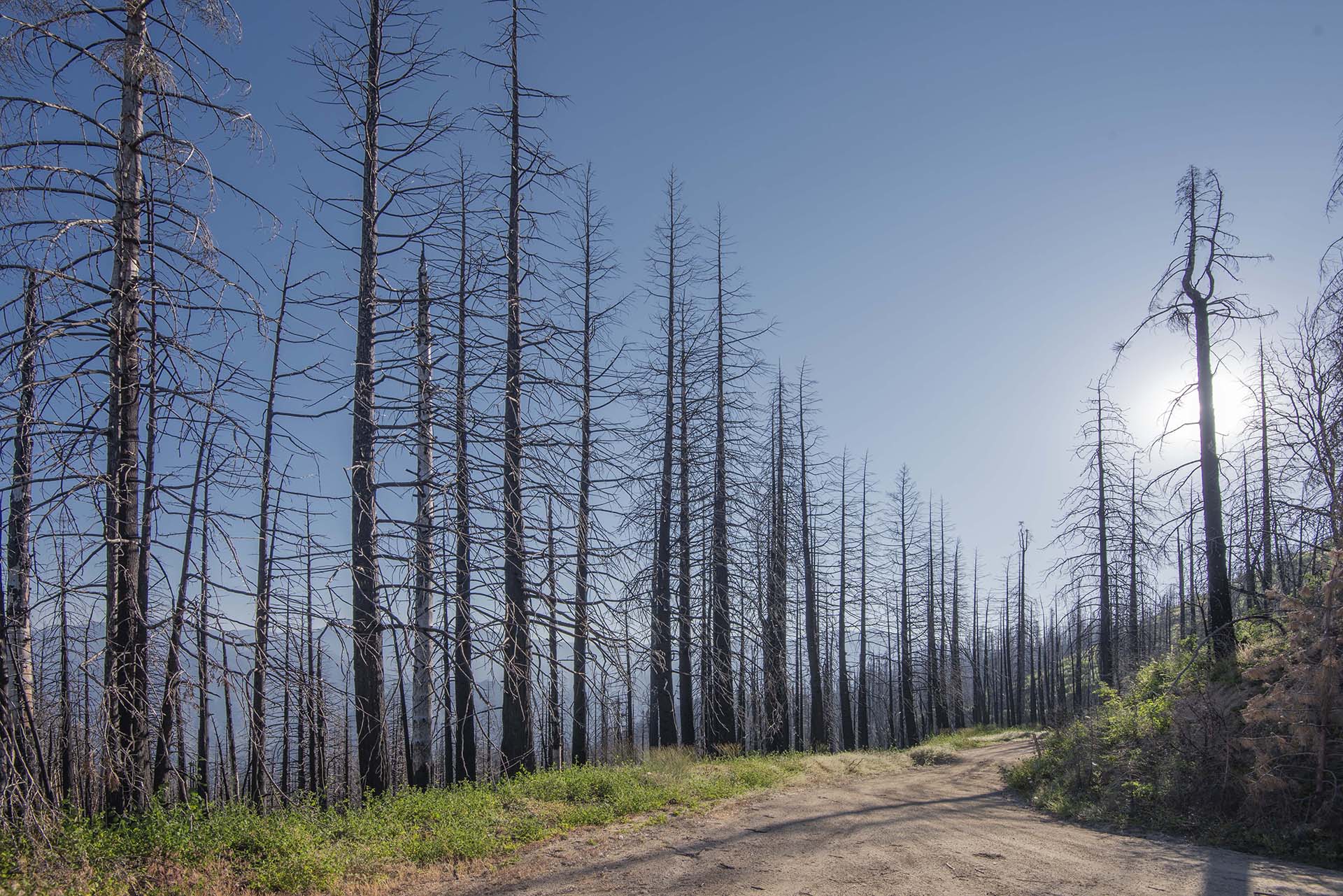 Black Mountain Grove, Pier Fire 2017 extreme severity burn, image from 2019
Black Mountain Grove, Pier Fire 2017 extreme severity burn, image from 2019
Mortality of 95 percent or greater in high-severity fire…
Stevens et al., Changing spatial patterns of stand-replacing fire in California conifer forests, Forest and Ecology Management, June 23, 2017.
https://www.fs.fed.us/psw/publications/north/psw_2017_north005_stevens.pdf
Average burn area per fire in the US has increased by 400 percent and the number of fires has decreased by 20 percent… Fires are getting bigger and harder to control resulting in greater burned area, where prevention and education have resulted in fewer overall fires.
Wildfire Statistics, Congressional Research Service, October 3, 2022.
https://sgp.fas.org/crs/misc/IF10244.pdf
United Nations Environmental Program Frontiers Report 2022: Wildfires, Chapter 22, Phenology Chapter 3… Chapter 2, “The observed trends towards more dangerous weather conditions for wildfires are projected to continue increasing, due to mounting concentrations of atmospheric greenhouse gases, with escalating risk factors.” And Chapter 3, “A major concern with phenological changes in response to climate change is that not all interdependent species in a particular ecosystem shift in the same direction or at the same rate… These mismatches between predator and food source within a food web will affect individuals’ growth, reproduction and survival rates, with eventual repercussions for whole populations and ecosystems.”
Frontiers 2022 – Noise, Blazes and Mismatches, United Nations Environmental Program, 2022.
https://wedocs.unep.org/handle/20.500.11822/38867
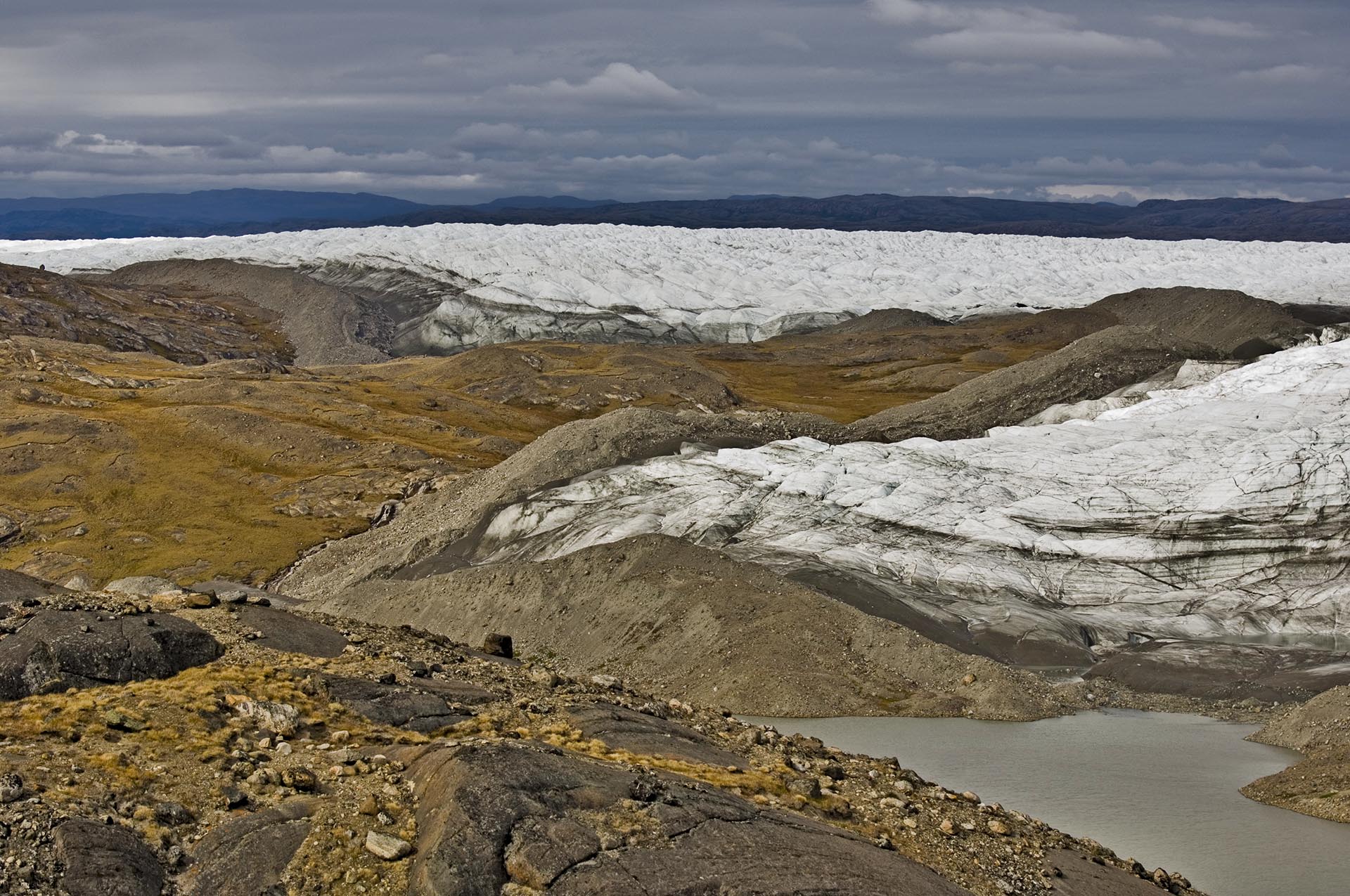
Greenland Ice Sheet, Point 660, 18 miles from Kangerlussuaq in 2007.
Normally, the ice sheet towers over the 200 foot tall terminal moraines.
Melt has more than doubled since 2007.
Tipping, Earth Systems Collapse, Evolutionary Boundaries
Five climate tipping points are likely now active… Parts of the West Antarctic ice sheet, Greenland ice sheet, Atlantic Meridional Overturning Circulation, and Amazon rainforest destabilization have plausibly been activated. Crossing these tipping points can generate positive feedbacks that increase the likelihood of crossing other climate tipping points.
McKay, Lenton et al., Exceeding 1.5 C global warming could trigger multiple climate tipping points, Science, September 9, 2022.
https://www.science.org/doi/10.1126/science.abn7950
The Latest Hockey Stick – Current warming is nearly twice the maximum of the last 2000 years, far exceeding the evolutionary boundaries of Earth Systems… The last 2000 years of the Holocene is the time period when our advanced civilization and the Earth systems that support our advanced civilization evolved. Ninety-five percent of the time during this period the average Earth temperature was no warmer than 0.4 C (0.72 F) warmer than the late 19th century. This period was an exceptionally stable period in our climate and represents the boundary conditions of the evolution of our Earth systems upon which our advanced civilization depends. Exceeding this natural variability of our old climate results in Earth systems collapse which is, or is directly related to climate tipping points.
Kaufman, Holocene global mean surface, a multi-method reconstruction approach Nature Scientific Data, June 2020.
https://www.nature.com/articles/s41597-020-0530-7#Sec11
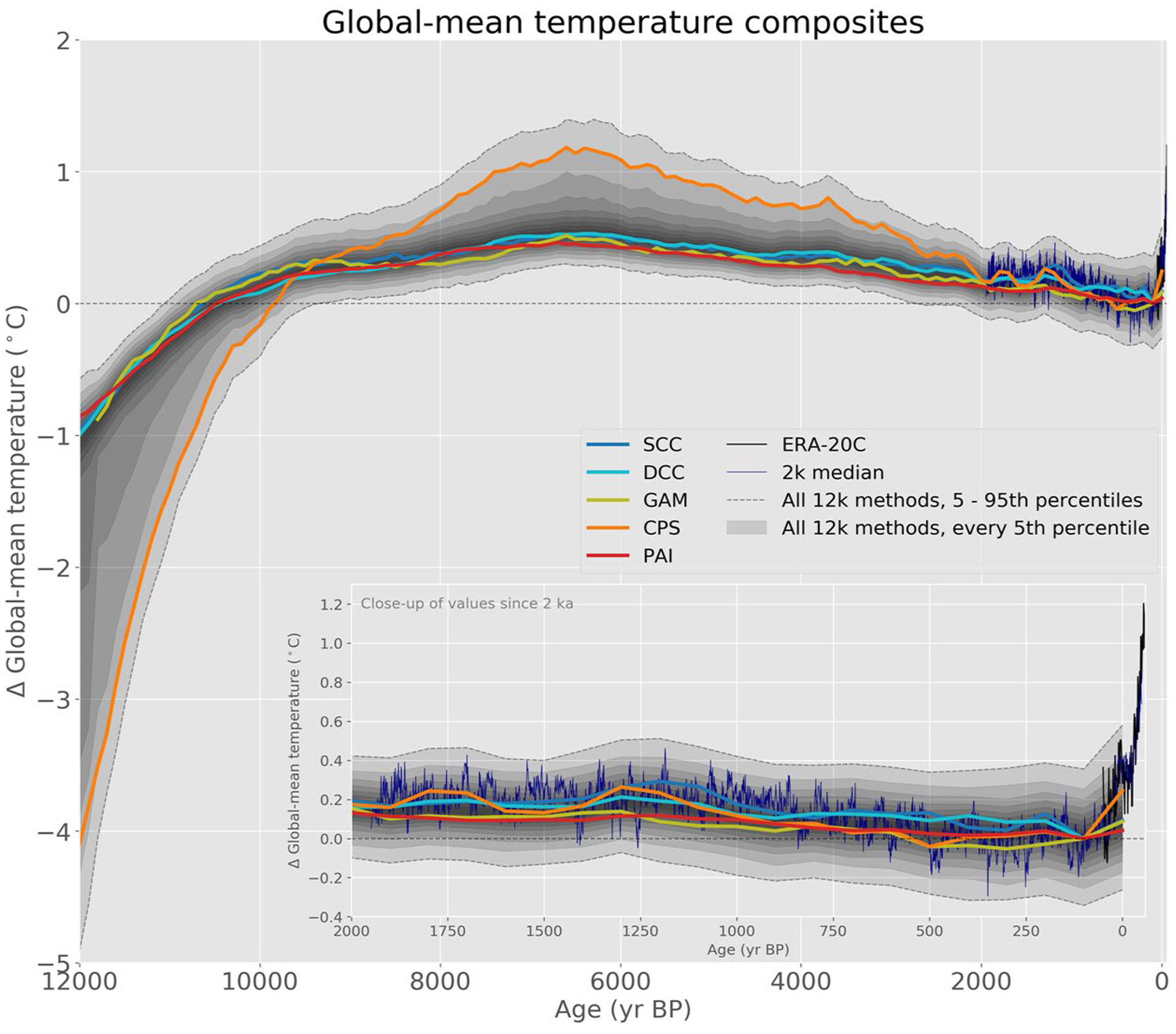 Different colored lines are different proxies for the average Earth temperature.
Different colored lines are different proxies for the average Earth temperature.
Black is the thermometer record. Gray shading represents 5% range (error) estimates.
Kaufman 2020.
Climate Endgame, Exploring catastrophic climate change scenarios…
“The proposed agenda covers four main questions: 1) What is the potential for climate change to drive mass extinction events? 2) What are the mechanisms that could result in human mass mortality and morbidity? 3) What are human societies’ vulnerabilities to climate-triggered risk cascades, such as from conflict, political instability, and systemic financial risk? 4) How can these multiple strands of evidence—together with other global dangers—be usefully synthesized into an “integrated catastrophe assessment”? It is time for the scientific community to grapple with the challenge of better understanding catastrophic climate change.”
Kemp et al., Climate Endgame, Exploring catastrophic climate change scenarios. PNAS, August 1, 2022.
https://www.pnas.org/doi/10.1073/pnas.2108146119
Extreme Marine Heat Events… In 2014, half of the oceans recorded heat events were as rare as or more rare than the 50-year event in our old climate. In 2019 it was 57%. In other words, the 50-year heat event in our oceans is happening every year across more than half of our oceans.
Tanaka and Van Houtan, The recent normalization of historical marine heat extremes, PLOS Climate, February 1, 2022.
https://journals.plos.org/climate/article?id=10.1371/journal.pclm.0000007
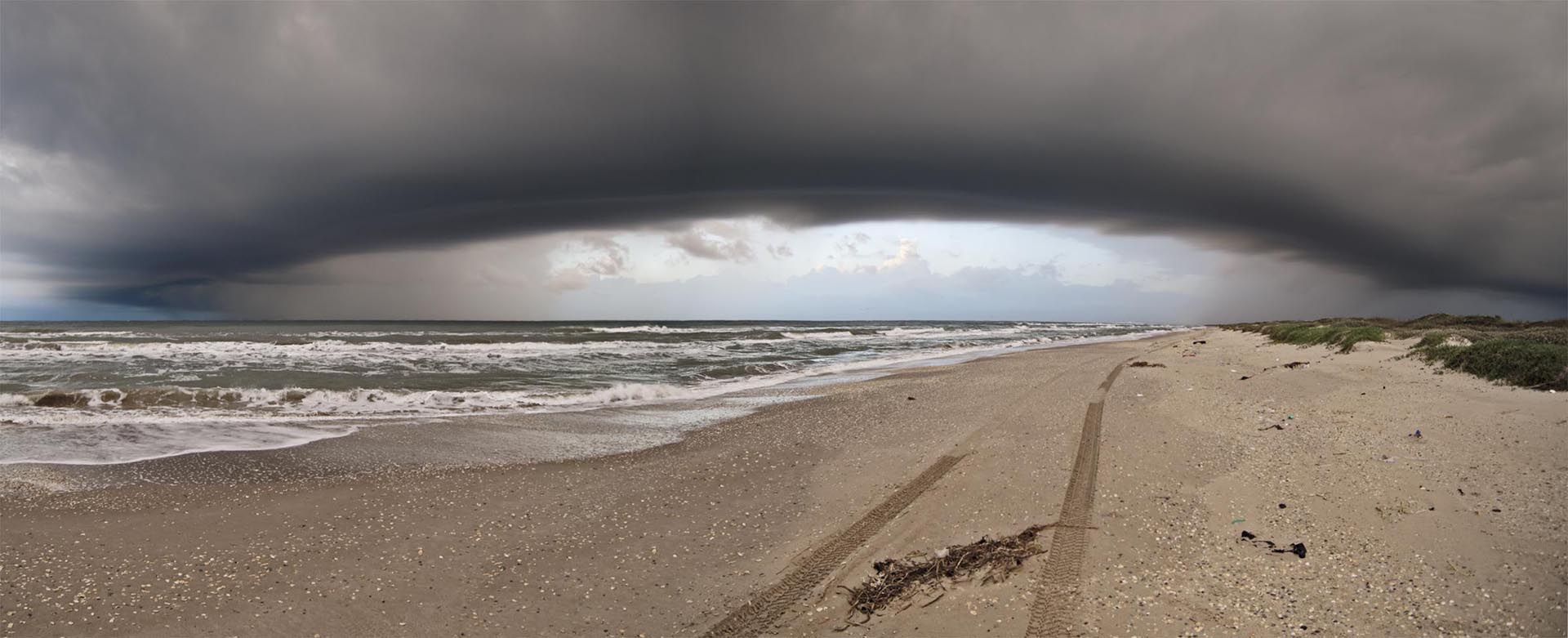 A fairy ring shower moves in from the Gulf of Mexico on Padre Island during King Tide.
A fairy ring shower moves in from the Gulf of Mexico on Padre Island during King Tide.
The highest tide overnight is evident in wet sand. This beach was 100 to 300 feet wide in 2013.
Evidence of dune erosion from previous tides can be seen on the right.
Collapsing barrier islands can self-restore if sea level rise is halted through climate restoration.
Bergstrom 2021 – Ecological collapse and mitigation… Bergstrom 2021 discusses trajectories of 19 ecosystems globally and presents a three-step management framework to aid in mitigation.
Bergstrom et al., Combating ecosystem collapse from the tropics to the Antarctic, Global Change Biology, January 12, 2021.
https://onlinelibrary.wiley.com/doi/10.1111/gcb.15539
Australian tropical forest tree mortality has doubled from water stress with ongoing halving of carbon storage, likely flipping Australian tropical forests from carbon sink to source… In a personal communication, Bauman says that it is likely that the same water stress that has created a doubling of mortality in Australian tropical forests has plausibly created the same kind of mortality doubling globally across all tropical forests.
Bauman et al., Tropical tree mortality has increased with rising atmospheric water stress, Nature, May 17, 2022.
(Researchgate, free account required) https://www.researchgate.net/publication/360691427_Tropical_tree_mortality_has_increased_with_rising_atmospheric_water_stress
Zoonosis
Viral spillover risks with a warming climate… “Risk increases with runoff from glacier melt, a proxy for climate change. [As] climate change also shift species range of potential viral vectors and reservoirs northwards, the High Arctic could become fertile ground for emerging pandemics.”
Lemieux et al., Viral spillover risk increases with climate change in High Arctic lake sediments, Proceedings of the Royal Society B, October 19, 2022.
https://royalsocietypublishing.org/doi/epdf/10.1098/rspb.2022.1073
Climate Change Countermovement
$10 billion in CCCM Funding 2003 to 2018… “Our dataset contains 49,354 grants from 3787 foundations to 116 out of the 128 eligible CCCM members, totaling $2.65 billion, over the period 2003 to 2018. Total contributions including untracked donations to the CCCM during this time totaled $9.77 billion.”
Brulle et al., Obstructing action, foundation funding and US climate change counter-movement organizations, Climatic Change, May 15, 2021.
https://www.cssn.org/wp-content/uploads/2020/10/Brulle2021_Article_ObstructingActionFoundationFun.pdf
Climate Change Counter-movement consists of over 2,000 associations with 179 core organizations…
Brulle, Networks of Opposition, A Structural Analysis of U.S. Climate Change Countermovement Coalitions 1989–2015, Sociological Inquiry, October 2019.
(Researchgate, free account required) https://www.researchgate.net/publication/336695509_Networks_of_Opposition_A_Structural_Analysis_of_US_Climate_Change_Countermovement_Coalitions_1989-2015
Social Media CCCM, Deny, Deceive Delay… “The failure to stem mis- and disinformation online has allowed junk science, climate delayism and attacks on climate figures to become mainstreamed… Far from helping to mitigate this issue, tech platform systems appear to be amplifying or exacerbating the spread of such content.”
King et al., Deny, Deceive, Delay, Documenting and Responding to Climate Disinformation, Institute for Strategic Dialogue, June 2022.
https://www.isdglobal.org/wp-content/uploads/2022/06/Deny-Deceive-Delay-Executive-Summary.pdf
Climate Restoration
Climate restoration pathways to 300 ppm CO2 addressing 1,500 gigatons CO2 removal by 2040 to 2100…
Fiume, Alternative Method to Determine A CDR Target, Open nanoCarbon, November 23, 2022. (white paper)
https://www.authorea.com/doi/pdf/10.1002/essoar.10503117.1
Is Climate Restoration an Appropriate Climate Policy Goal?… Pursuit of climate restoration to 300 ppm CO2 via numerous strategies of atmospheric CO2 removal would not only decrease the great risks from climate change we face with further warming to a 1.5 C or 2 C target, but it would catalyze solutions to assist in decarbonization of our global culture.
Lempert et al., Is Climate Restoration an Appropriate Climate Policy Goal?, Rand Corporation, 2018.
https://www.rand.org/content/dam/rand/pubs/research_reports/RR2400/RR2442/RAND_RR2442.pdf
Scenario Bias
Excluded futures, the continuity bias in scenario assessments – Contemporary climate scenarios do not represent unconventional outcomes… “Global scenario assessments in support of climate, biodiversity, energy and other international policy deliberations tend to focus on a narrow bandwidth of possibilities: futures that unfold gradually from current patterns and trends. This “continuity bias” downplays the real risks [from unexpected scenarios.] The COVID-19 pandemic, a concrete illustration of historical discontinuity, underscores the critical importance of emphasizing nonconventional futures in policy assessments.”
Raskin and Swart, Excluded futures, the continuity bias in scenario assessments, Sustainable Earth, July 8, 2020.
https://sustainableearth.biomedcentral.com/track/pdf/10.1186/s42055-020-00030-5.pdf
Changes needed to IPCC scenario framework… “Identified changes needed to address diverse boundary conditions, futures cooler than 1.5 C, shocks including abrupt climate change and climate tipping, and restoration scenarios.”
O’Neill et al., Achievements and needs for the climate change scenario framework, Nature, November 25, 2020.
https://www.nature.com/articles/s41558-020-00952-0.pdf
Climate models (economic) are grossly misleading – “Current economic models tend to underestimate seriously both the potential impacts of dangerous climate change and the wider benefits of a transition to low-carbon growth. There is huge potential in future technologies that can drive change. These are omitted or badly underestimated in our current climate modelling — deeply damaging our guidance for policymaking.”
Stern, Economics – Current climate models are grossly misleading, Nature, February 25, 2016.
https://www.nature.com/articles/530407a
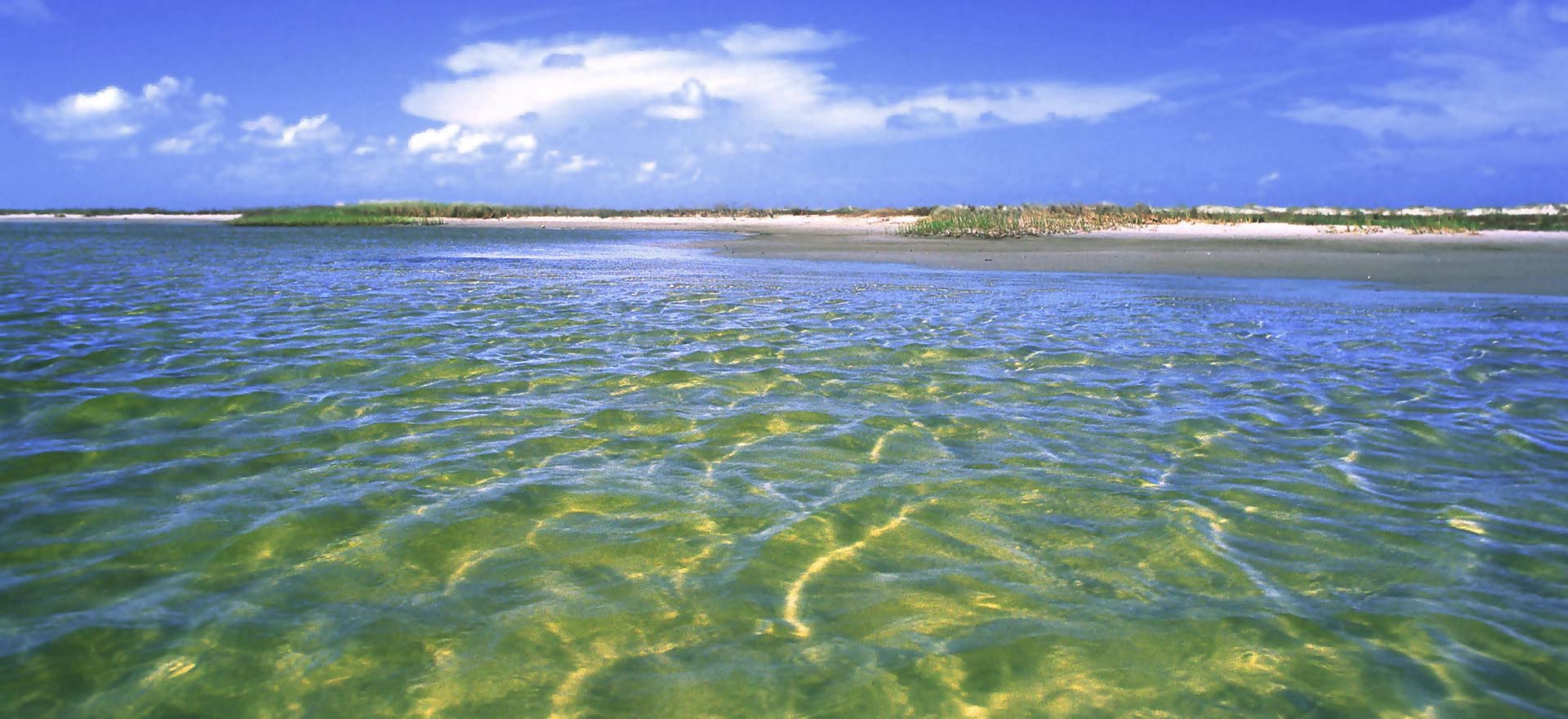
Solutions
International Energy Agency Report, Direct Air Capture, A Key Technology for Net Zero…
“Capturing CO2 directly from the air and permanently storing it removes the CO2 from the atmosphere, providing a solution for legacy emissions as well as a way to balance emissions that are difficult to avoid…The potential for DAC to contribute to climate change mitigation is increasingly being recognized, with the technology benefiting from new public and private initiatives.”
Direct Air Capture, A Key Technology for Net Zero, IEA, April 2022.
https://www.iea.org/reports/direct-air-capture-2022
Hard to decarbonize sectors, Brookings Institute… “Heavy industry makes products that are central to our modern way of life but is also responsible for nearly 40% of global carbon dioxide (CO2) emissions. Steel, cement, and chemicals are the top three emitting industries and are among the most difficult to decarbonize, owing to technical factors like the need for very high heat and process emissions of carbon dioxide, and economic factors including low profit margins, capital intensity, long asset life, and trade exposure.”
Gross, The Challenge of Decarbonizing Heavy Industry, Brookings Institute, 2021.
https://www.brookings.edu/wp-content/uploads/2021/06/FP_20210623_industrial_gross_v2.pdf
Engineered Carbon Dioxide Removal (CDR), Scalability and Durability… A range of policy interventions could accelerate the equitable deployment of engineered CDR technologies.
Abouelnaga, Engineered Carbon Dioxide Removal, Scalability and Durability. Center for Climate and Energy Solutions, October 2022.
https://www.c2es.org/wp-content/uploads/2022/10/engineered-carbon-dioxide-removal-scalability-and-durability.pdf
Solar on Superstores Report… Rooftop solar on large retail and commercial spaces is a widely underestimated solution with huge benefits. Costs are not that much greater, structural modification to roofs are generally not needed, cost savings to large rooftop facilities are significant, and reduction of greenspace is reduced, which when considering the very large amount of renewable energy needed is meaningful.
Solar on Superstores, Environment American and Frontier Group, January 22, 2022.
https://environmentamerica.org/center/resources/solar-on-superstores-2/
Solar above Parking… Putting solar generation on open land doesn’t necessarily make this a smart thing. Benefits of solar over parking are shade, revenues from shade covered parking, and less transmission needed to deliver power, as well as conservation of open space and farmlands needed to grow food.
Yale Environment 360, Why Putting Solar Canopies on Parking Lots Is a Smart Green Move
https://e360.yale.edu/features/putting-solar-panels-atop-parking-lots-a-green-energy-solution
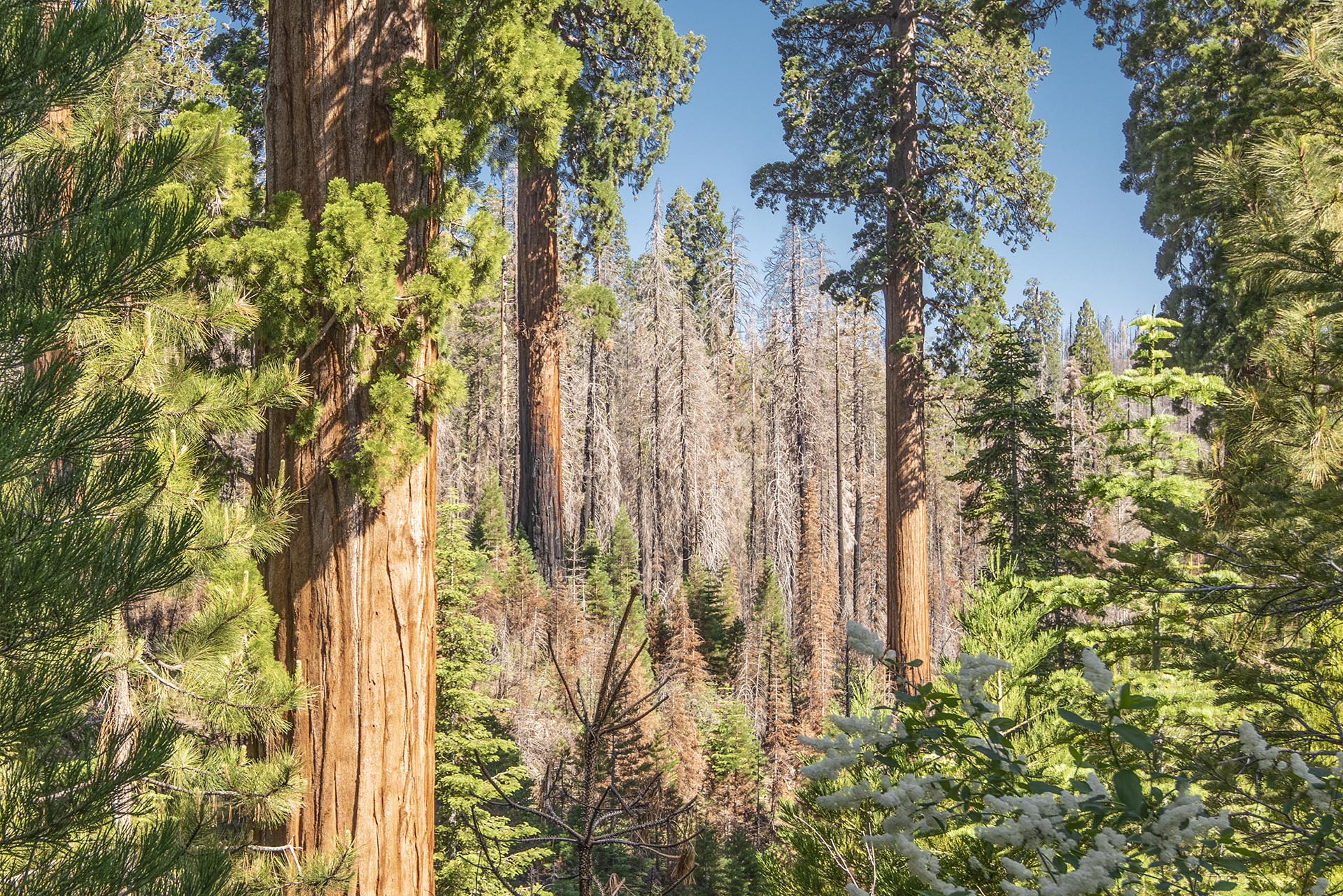 This is what a big burn in a sequoia grove is supposed to look like.
This is what a big burn in a sequoia grove is supposed to look like.
Sequoia’s tall stature rises above the flames.
Black Mountain Grove, Pier Fire, 2017.
The Good News
Counterintuitively, reports that there is “No credible pathway to 1.5°C in place,” that impacts are already irreversible, that the recent extreme weather events are here to stay, that we can only avoid the worst of climate change; these reports are not valid as they are based on scenarios where, there are no climate restoration scenarios. None of the 1,202 scenarios evaluated by the Intergovernmental Panel on Climate Change (IPCC), the consensus climate science reporting organization that is the most important resource in the development of climate policy and public understanding of climate change; none of the scenarios IPCC evaluates have a warming target of less than 1.5 C. Impacts that are already ongoing; of course they are irreversible if we allow further warming. Factually, theses ongoing impacts are irreversible if we were to magically halt all warming this instant. However, if we cool Earth back to within the evolutionary boundaries of her systems, back to below today’s temperature or the temperature of our planet in the recent past when all the mayhem started, the mayhem returns to its previously rare levels.

